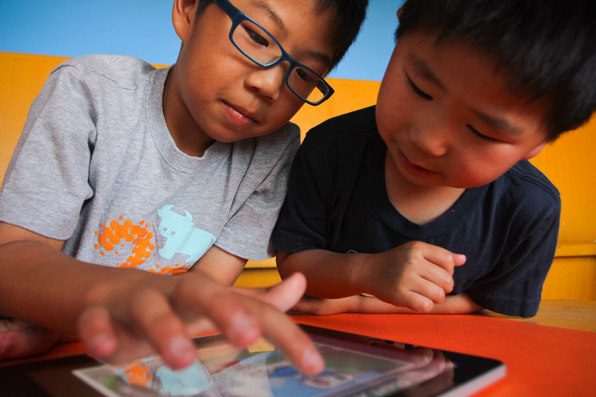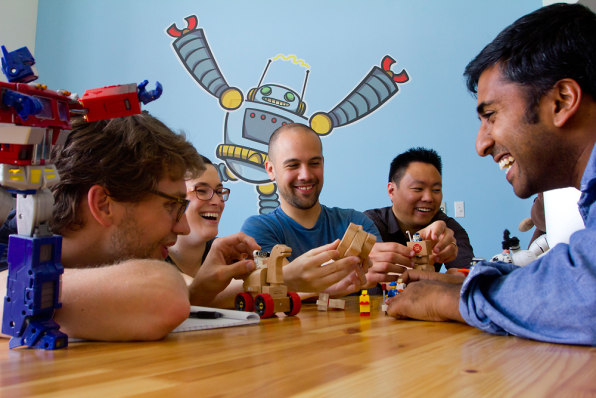How to Make Peter Buy Designer Toys
Quick, find a cardboard box, a magic marker, scissors, one roll of tape, and three everyday objects on your desk. Your task: Build an intergalactically awesome spaceship using just these parts. You have five minutes to complete this mission before this webpage 404s. 3-2-1 … go! (Seriously, you should do this–it's fun.)
Now that your ship's out of the hangar and ready for liftoff, let's look back on the design decisions you made along the way. How does your ship fly? What does it carry? Is that a robotic arm made out of paperclips? Does your spaceship shoot staples? Wowzers.
Fun as it may have been, the past five minutes have actually been quite educational (surprise!). You've been exercising a critical cognitive skill known as divergent thinking: the ability to see things not for what they are but for what they could be. You flipped a switch and said to yourself: What if that staple remover was actually a giant claw, that pen a torpedo, that TPS report, well, something more interesting than a TPS report. Without you even knowing it, your brain scanned the objects around you, assessed their physical and aesthetic properties, and mapped those features onto alternative symbolic identities.
These divergent thinking skills, practiced and honed through years of imaginative play in childhood, lie at the heart of our creative abilities as adults. In creative play we invent, prototype, test, and iterate on our designs–exercising and training for future lab experiments and boardroom brainstorms. So how do we as parents, educators, and designers of play help prepare our future innovators for what Daniel Pink is calling the "conceptual age"? With the United States shedding 1,600 industrial jobs each day (the average since 2006), our creative class is not just growing (30% and climbing) it's earning 50% of total wages. Creativity is no longer just a "nice-to-have"; it's a critical tool for economic survival at a time when rote tasks can be performed by anyone anywhere and information is just a click away. Tomorrow's workplace will value our children more for their ability to create new ideas than recall facts or replicate processes. So if creativity is not a defined genetic trait but a skill and process practiced over time (as Jonah Lehrer argues in Imagine), then what can we do now to inspire and foster creative development from a young age?
Unfortunately, recent studies have shown that the current approach isn't working. Creative Quotient scores (a creativity measure developed and tracked since the 1950s whose correlation to creative success is three times stronger than IQ) are showing a significant downward trend in children between the ages 4 and 10. As children spend more and more time taking standardized tests and engaging in highly structured play (organized sports, video games, etc.), open-ended and imaginative play is being marginalized.
The answer, quite simply, is to take back creative play by reimagining it for the modern era. Kids create, learn, and share their ideas through imaginative play. With pirate costumes, dolls, saucepan drum sets, and refrigerator-box moon bases kids aren't just practicing for "real life," they're training their brains to see new possibilities–building the "what if" skills that will be critical to their creative success in later years.
However, with "kids getting older younger" (a common lament in the toy Industry) and increasingly favoring digital games to traditional toys, it's our responsibility as toy designers to embrace the brilliant possibilities mobile devices afford for digital play. Phones and tablets empower our kids to collaborate through multi-touch, narrate their creations, share their ideas with other kids online, see the world through augmented-reality lenses, and explore the great outdoors with GPS. These aren't just video games anymore: They're an open platform for the greatest toys and creative tools yet to be invented.

Imagination, collaboration, and communication are the leading literacies of tomorrow's creative economy and at Launchpad Toys we're embracing three simple guidelines to create a new generation of digital toys for creative play and learning:
1. Toys, Not Games
Toys are open-ended tools that spark the imagination and inspire kids to create and produce their own stories, inventions, recipes, songs, and more. Games, on the other hand, are inherently defined. You start at Point A, end at Point B, and achieve a few predetermined tasks along the way. We've seen a lot of digital games over the years but not too many open-ended software "toys." With their multi-touch screens, microphones, accelerometers, and GPS chips, mobile phones and tablets enable us to empower kids as content producers–not just consumers.
2. Family Playtime = Creative Collaboration
Building a creative learning tool doesn't require you to bottle a teacher inside your software. Good teachers are dynamic, charismatic, and really good listeners; computers are not. As designers, we should be encouraging conversations and collaborative learning, rather than trying to instruct or quiz the child. Parents are looking for opportunities to play and co-create with their kids. Embrace multi-touch interfaces and narrative play patterns. Support parents with supplementary materials that will help them guide their child, rather than relying on the software to be a tutor. Let's stop isolating kids in the "computer room" and get them away from the TV, so they can play in the backyard and at the kitchen table and collaborate with their greatest mentors and advocates: their families.

3. Give Kids a Megaphone and a Rooftop to Shout From
We affectionately call our children's storytelling and animation app Toontastic, a "global storytelling network for kids." As important as it is to inspire and scaffold a child's creative process, the greater opportunity lies in the social learning and feedback of a well-structured online community. By enabling kids to share their ideas with others, we not only validate and celebrate their creativity; we give them the opportunity to iterate on their work based on the feedback of their peers. Further, we offer them a chance to walk in the shoes of others around the world, not through outdated social-studies textbooks but through the creations of other kids just like them.

From the most agile startups to corporate titans like Apple and Google, today's innovators and tomorrow's leaders are dispelling the myths of the "auteur" and the "eureka moment" in favor of needs-driven, iterative, and collaborative design methodologies. These models depend upon the creative skills we develop and hone through play from the earliest ages–imagination, collaboration, and communication–and it's imperative that we embrace that cardboard spaceship designer in all of us to re-imagine childhood through new lenses (screens) that empower children to create, learn, and share their ideas with the world.
This piece is part of a Collaborative Fund-curated series on creativity and values written by thought leaders in the for-profit, for-good business space.
How to Make Peter Buy Designer Toys
Source: https://www.fastcompany.com/1669691/3-ways-to-design-toys-that-boost-kids-creativity